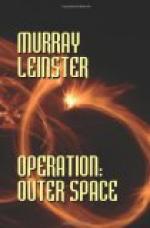“It worked,” he said mildly.
“I know it worked!” sputtered Cochrane. “But—where are we? How far did we come?”
“I haven’t the least idea,” said Jones mildly as before. “Does it matter?”
Cochrane glared at him. Then he realized how completely too late it was to protest anything.
The man he had seen absorbed in the handling of controls now lifted his hands from the board. The rockets died. There was a vast silence, and weightlessness. Cochrane weighed nothing. This was free flight again—like practically all of the ninety-odd hours from the space platform to the moon. The pilot left the controls and in an accustomed fashion soared to a port on the opposite side of the room. He gazed out, and then behind, and said in a tone of astonished satisfaction:
“This is good!—There’s the sun!”
“How far?” asked Jones.
“It’s fifth magnitude,” said the pilot happily. “We really did pile on the horses!”
Jones looked momentarily pleased again. Cochrane said in a voice that even to himself sounded outraged:
“You mean the sun’s a fifth-magnitude star from here? What the devil happened?”
“Booster,” said Jones, nearly with enthusiasm. “When the field was just a radiation speed-up, I used forty milliamperes of current to the square centimetre of field-plate. That was the field-strength when we sent the signal-rocket across the crater. For the distress-torpedo test, I stepped the field-strength up. I used a tenth of an ampere per square centimetre. I told you! And don’t you remember that I wondered what would happen if I used a capacity-storage system?”
Cochrane held fast to a hand-hold.
“The more power you put into your infernal field,” he demanded, “the more speed you get?”
Jones said contentedly:
“There’s a limit. It depends on the temperature of the things in the field. But I’ve fixed up the field, now, like a spot-welding outfit. Like a strobe-light. We took off with a light field. It’s on now—we have to keep it on. But I got hold of some pretty storage condensers. I hooked them up in parallel to get a momentary surge of high-amperage current when I shorted them through my field-making coils. Couldn’t make it a steady current! Everything would blow! But I had a surge of probably six amps per square centimetre for a while.”
Cochrane swallowed.
“The field was sixty times as strong as the one the distress-torpedo used? We went—we’re going—sixty times as fast?”
“We had lots more speed than that!” But then Jones’ enthusiasm dwindled. “I haven’t had time to check,” he said unhappily. “It’s one of the things I want to get at right away. But in theory the field should modify the effect of inertia as the fourth power of its strength. Sixty to the fourth is—.”
“How far,” demanded Cochrane, “is Proxima Centaurus? That’s the nearest star to Earth. How near did we come to reaching it?”




